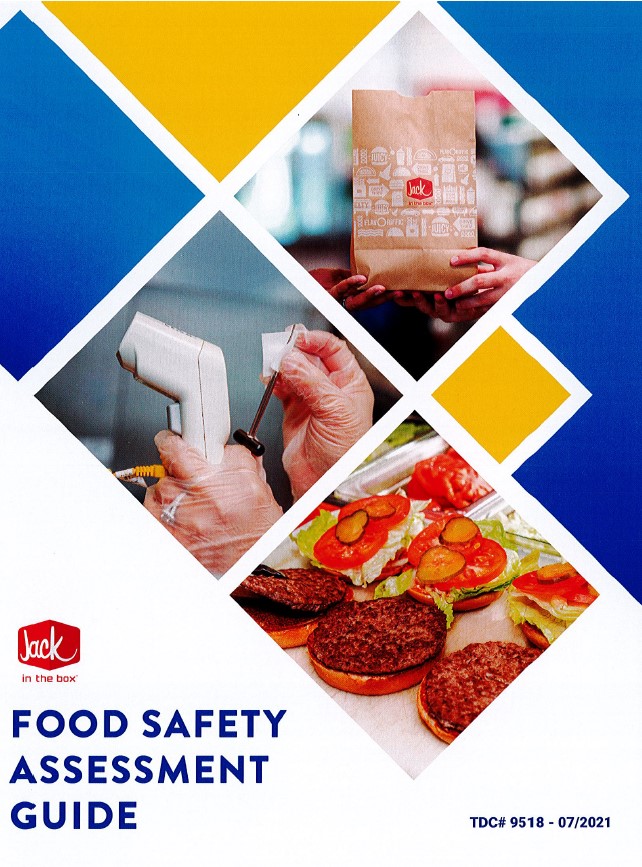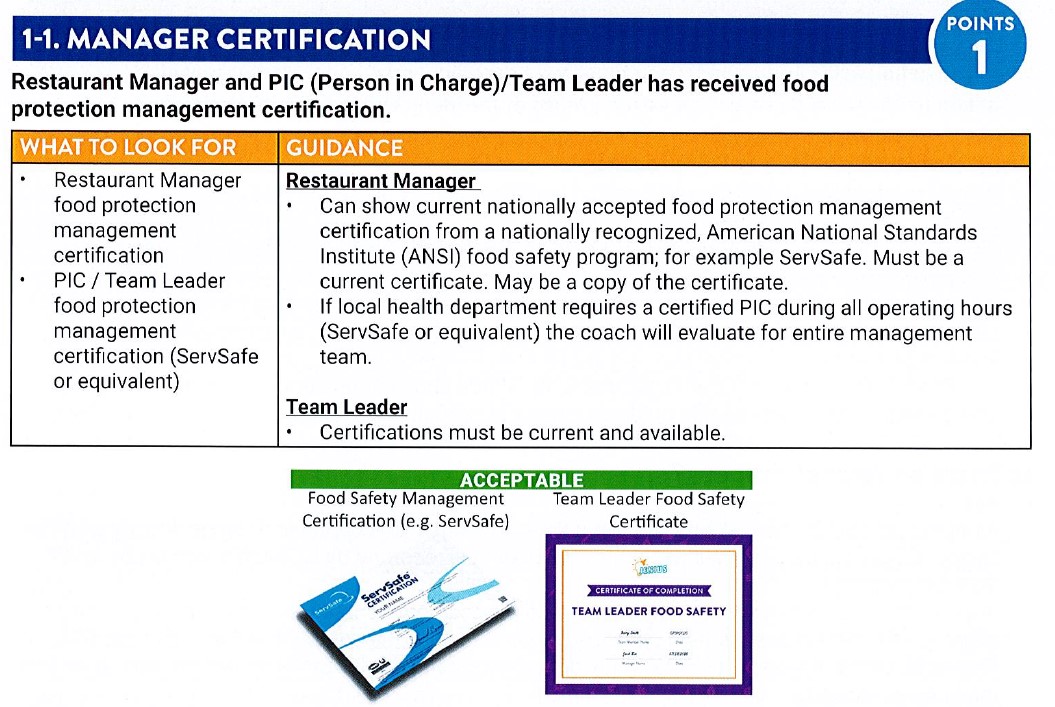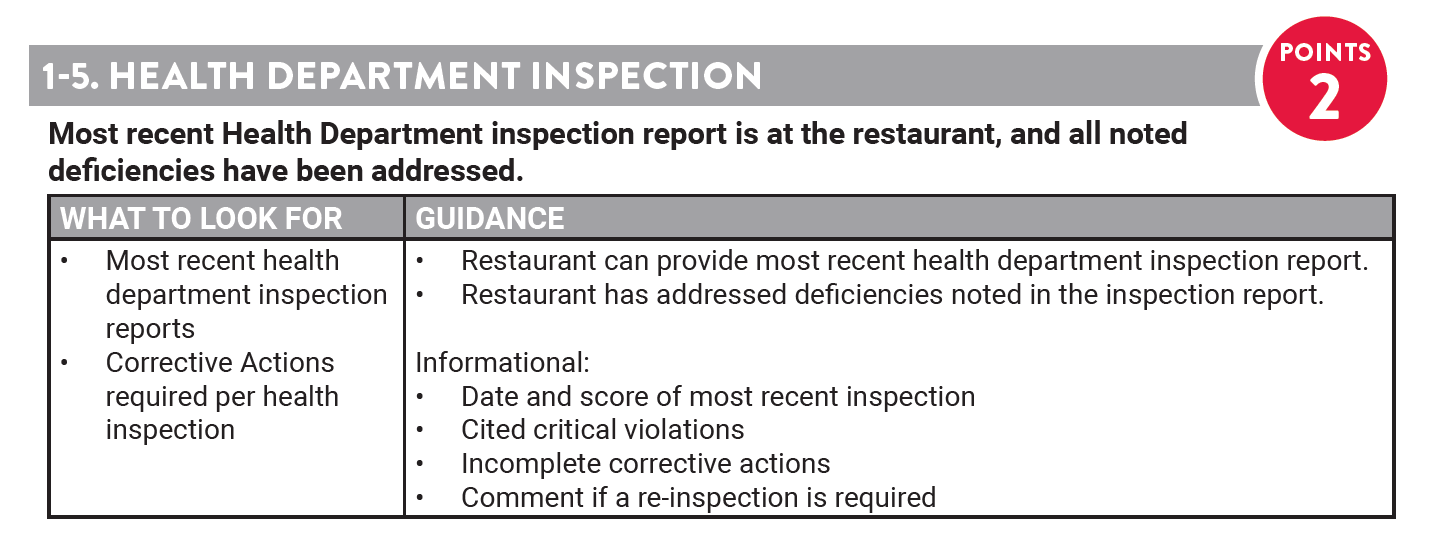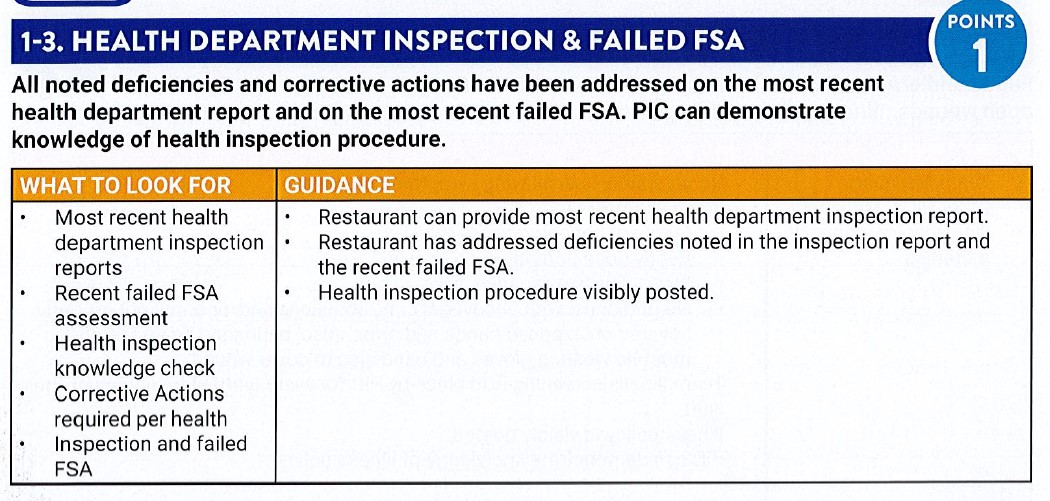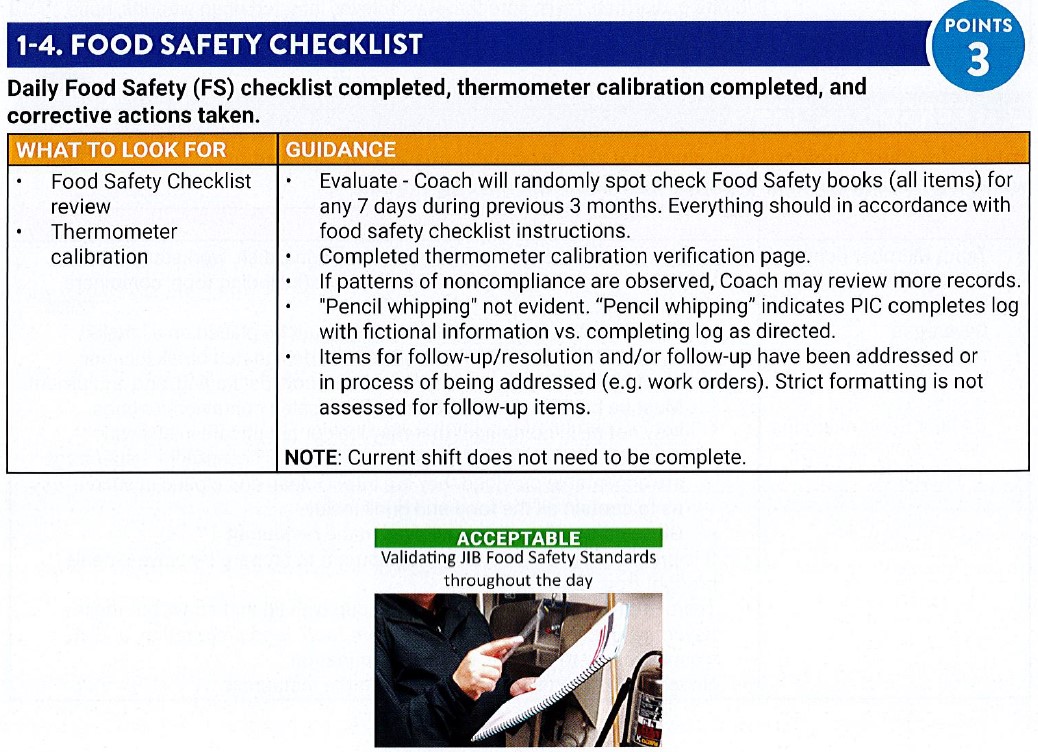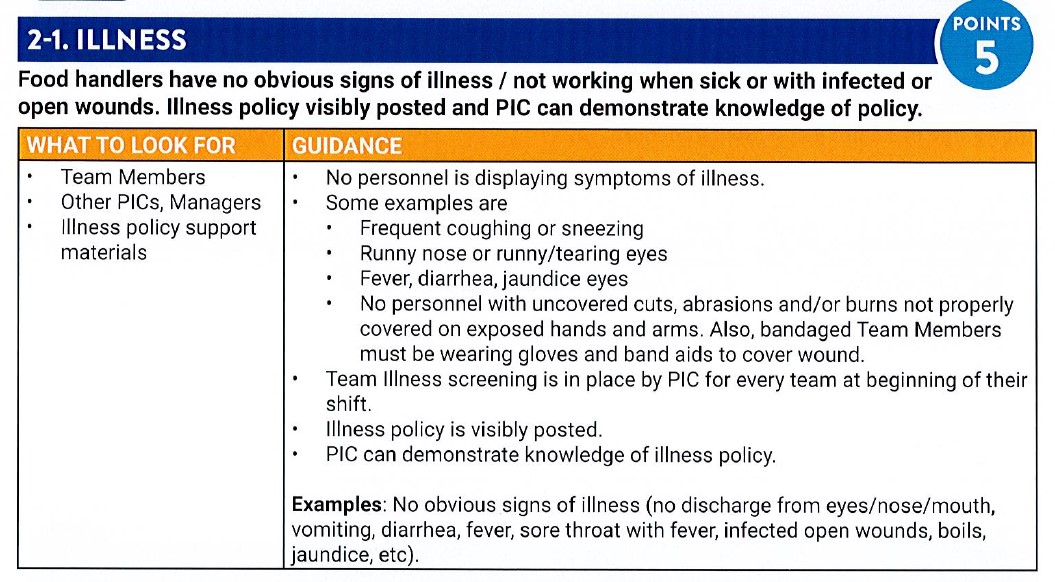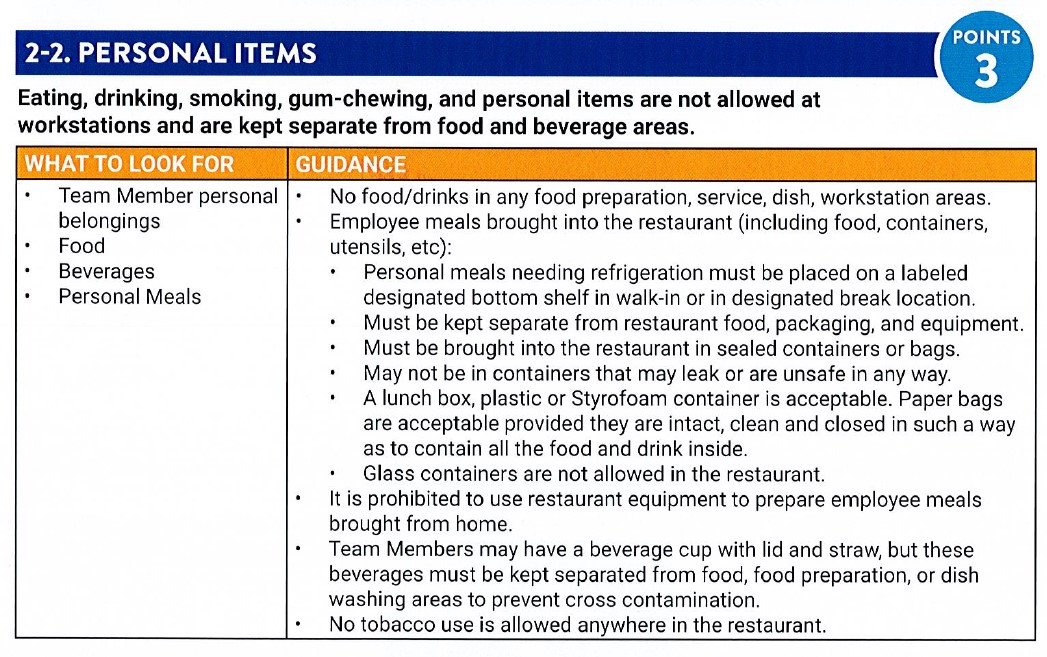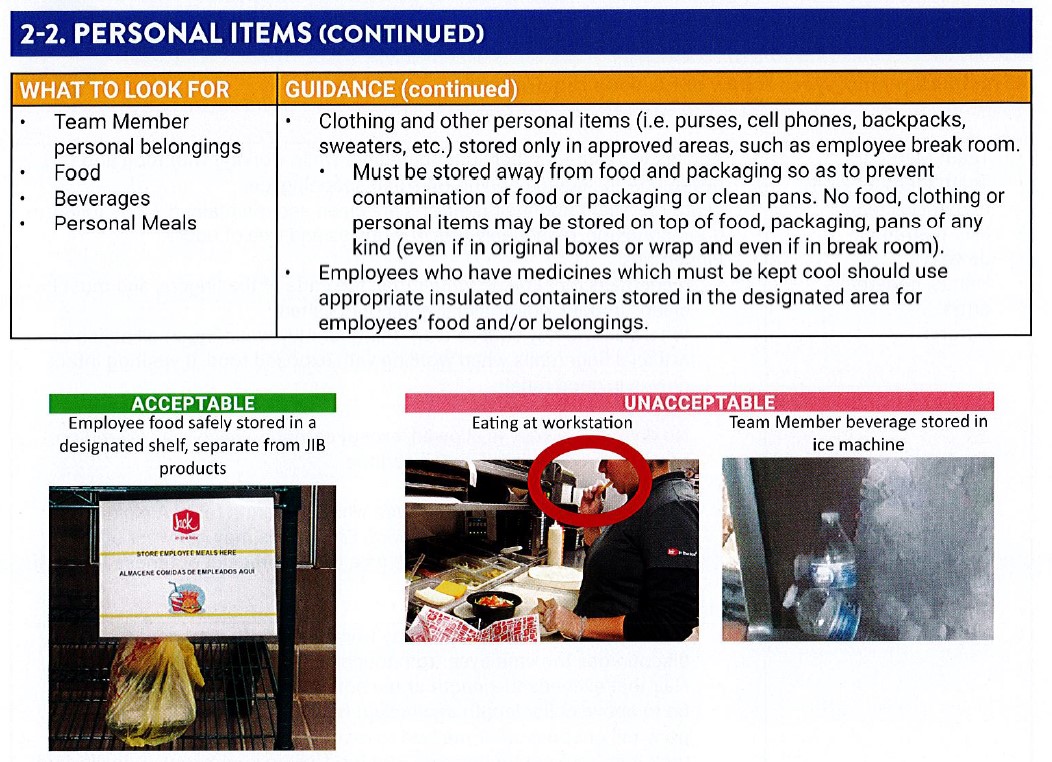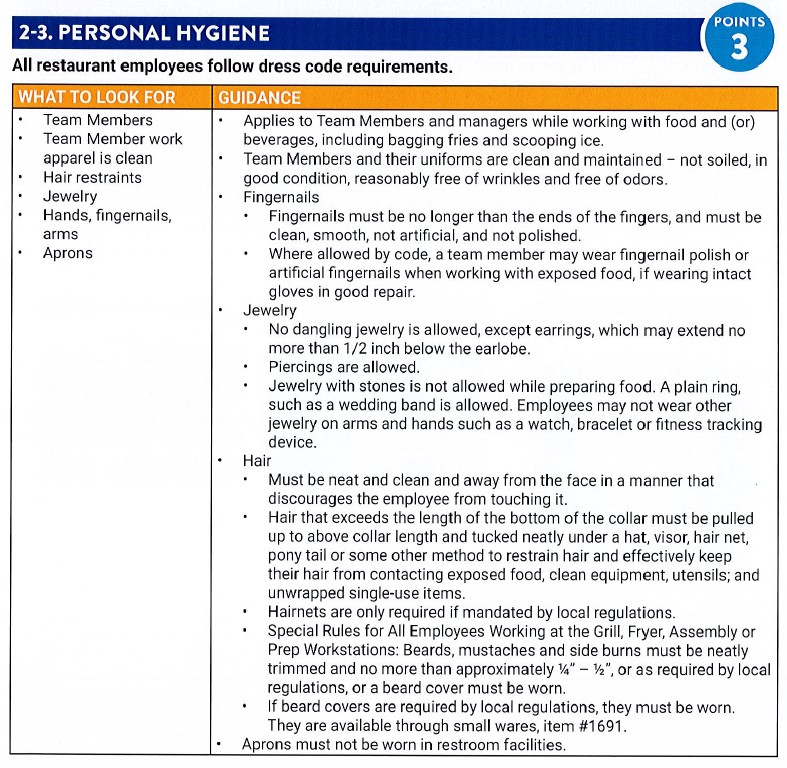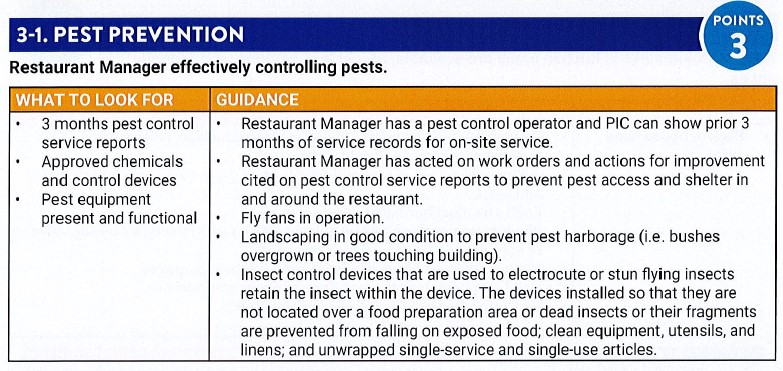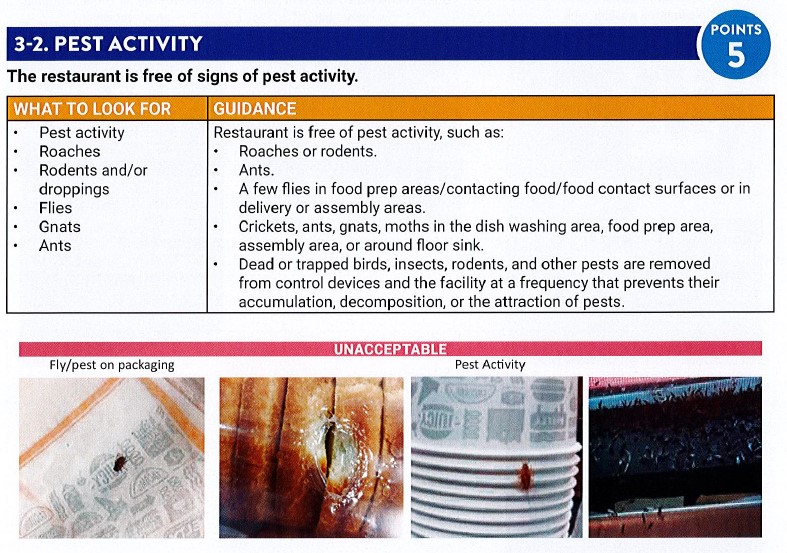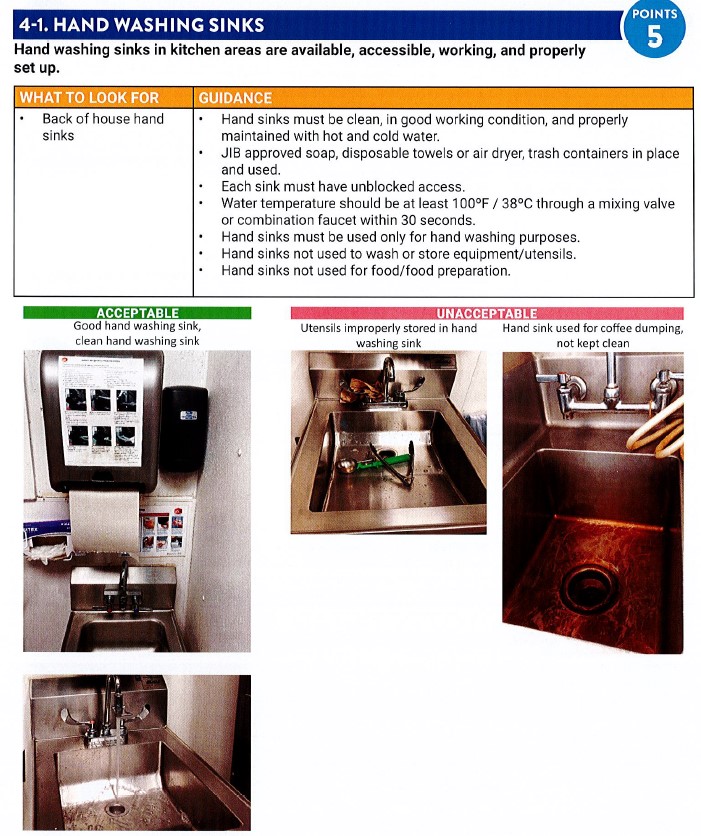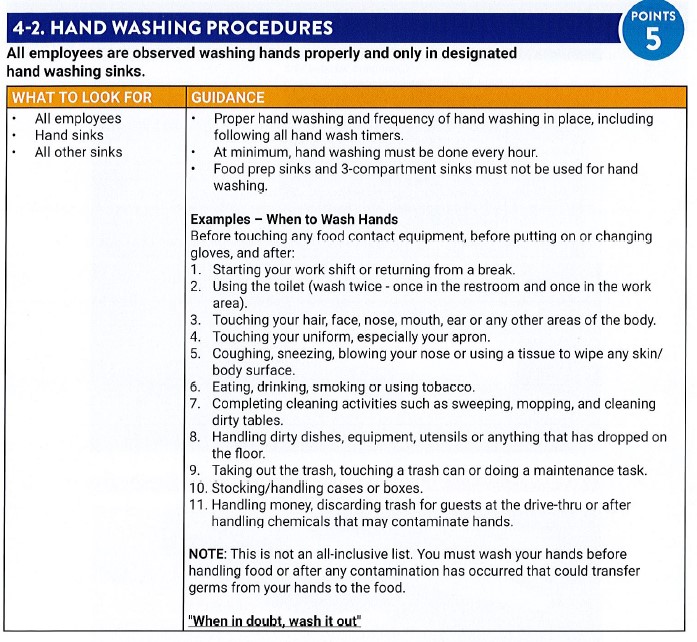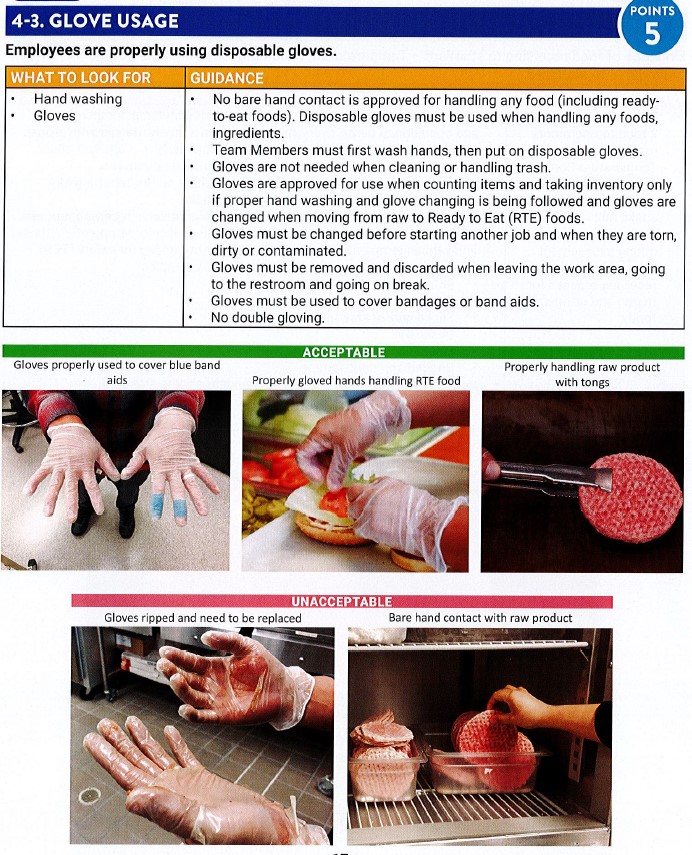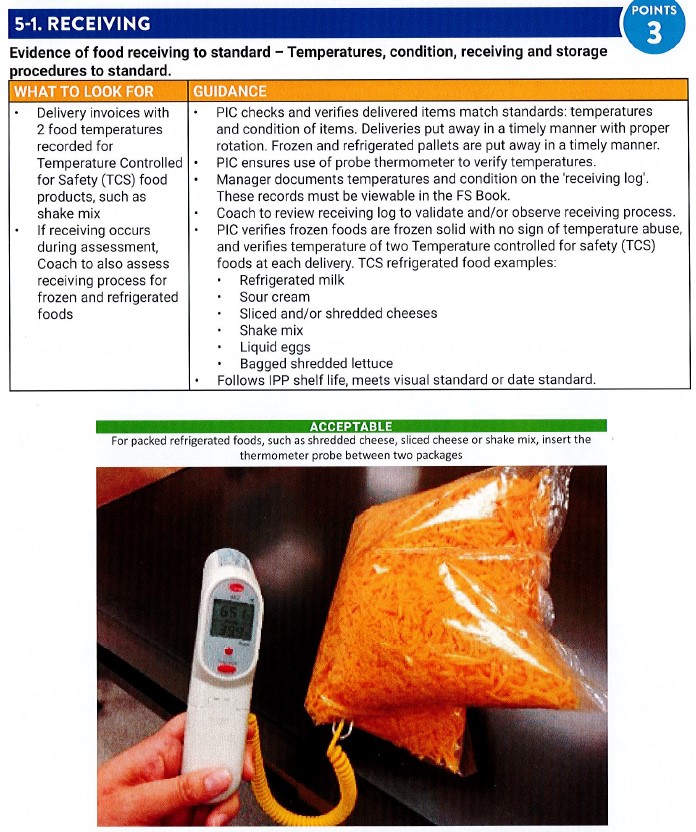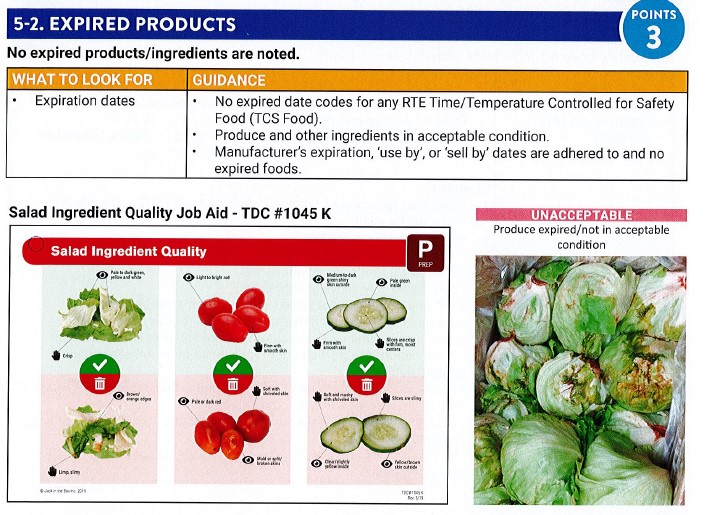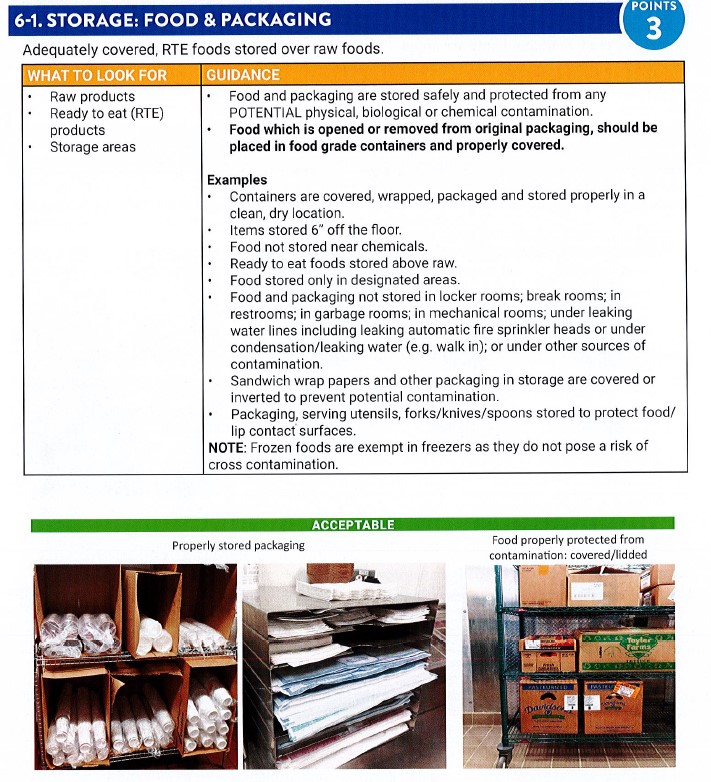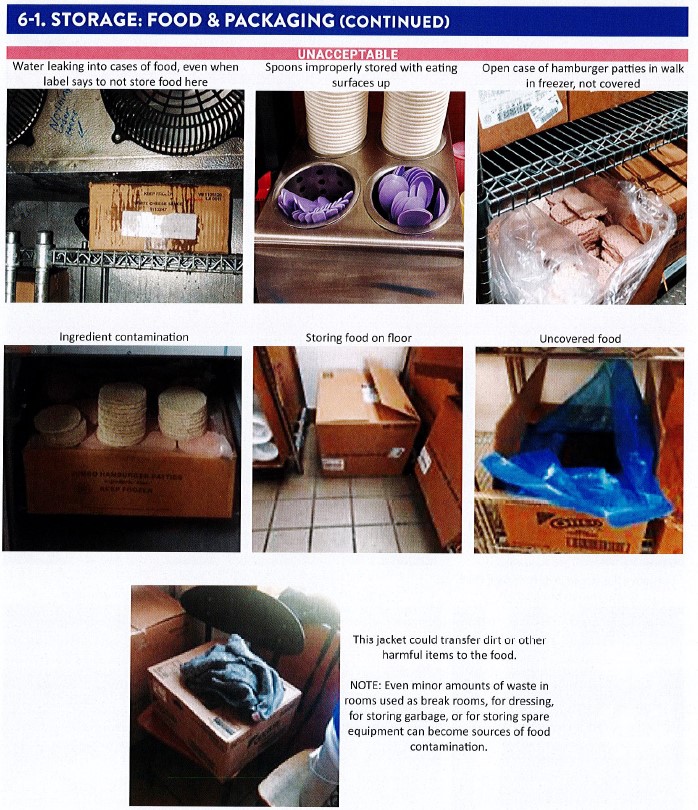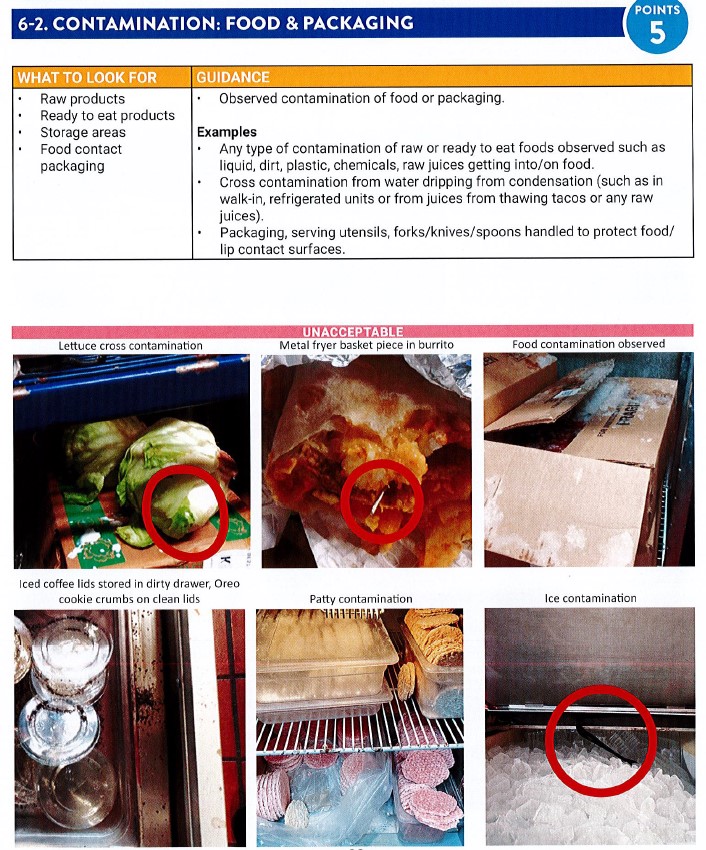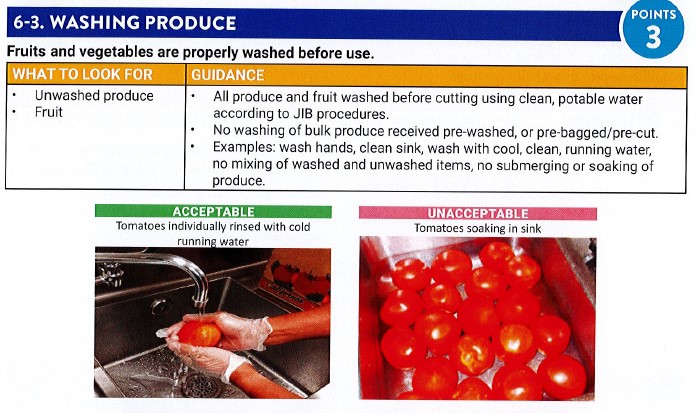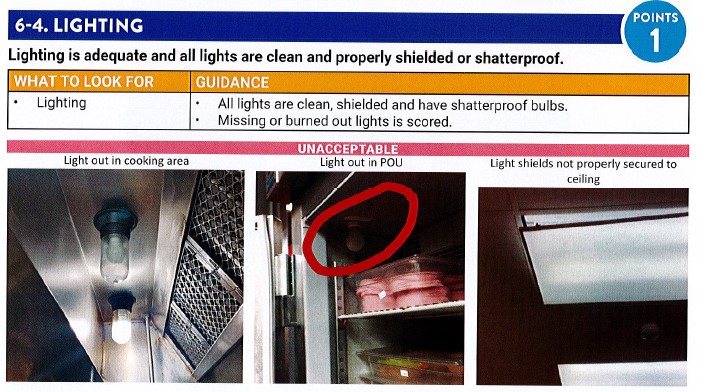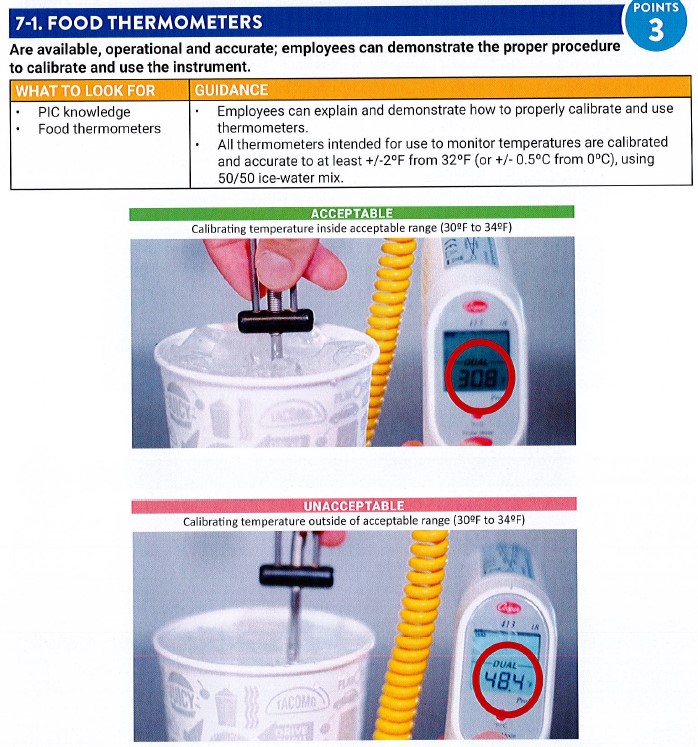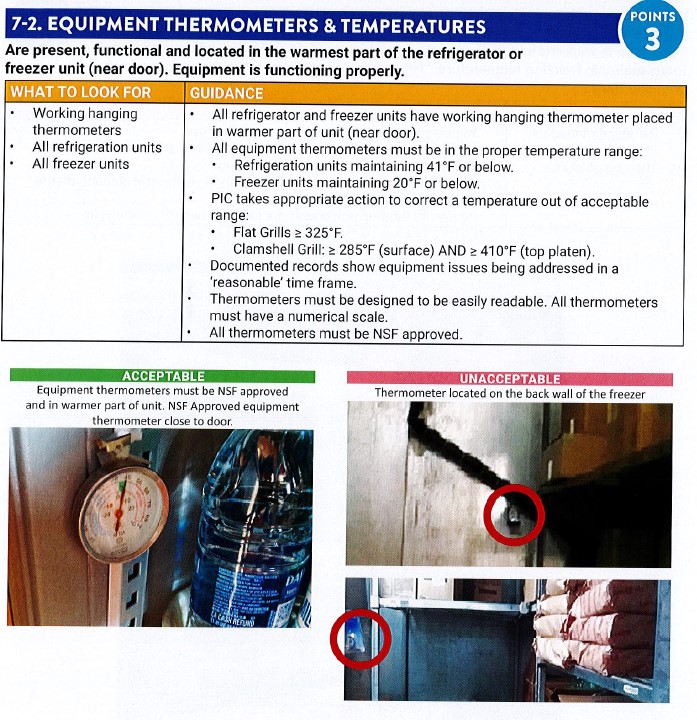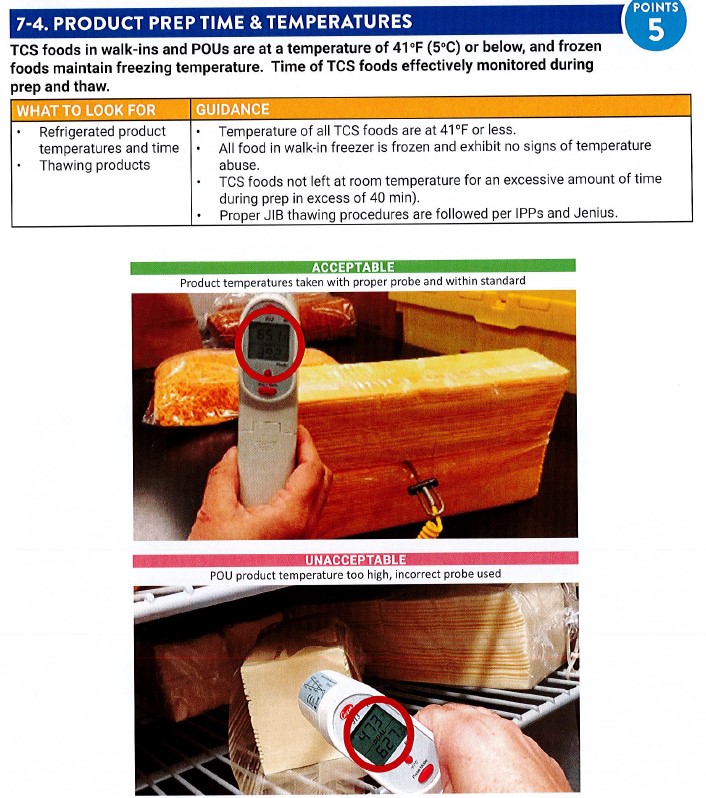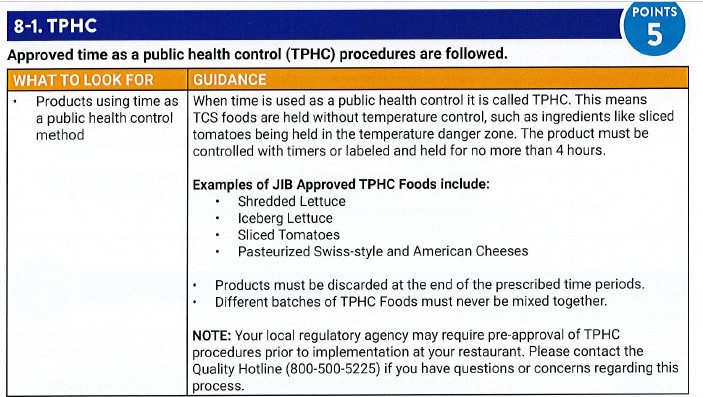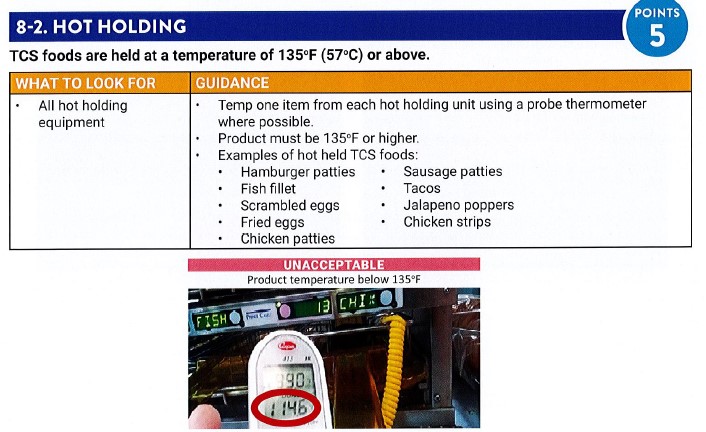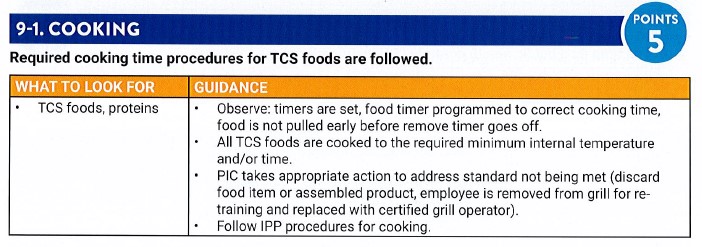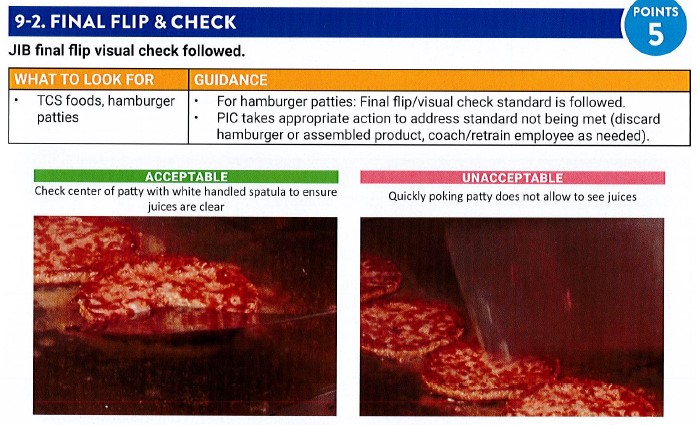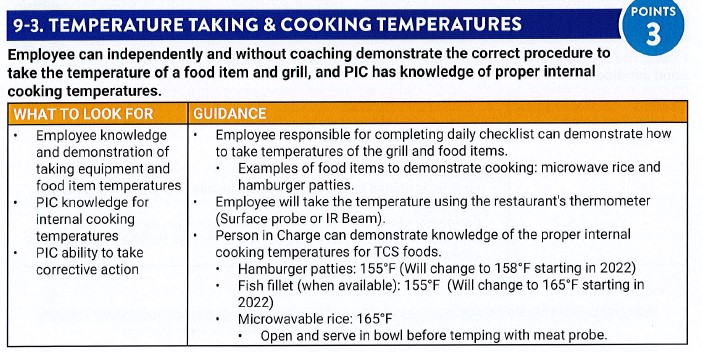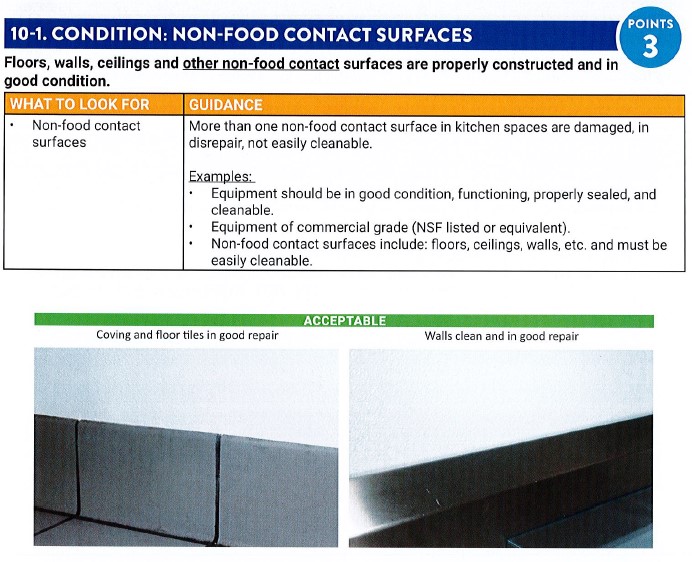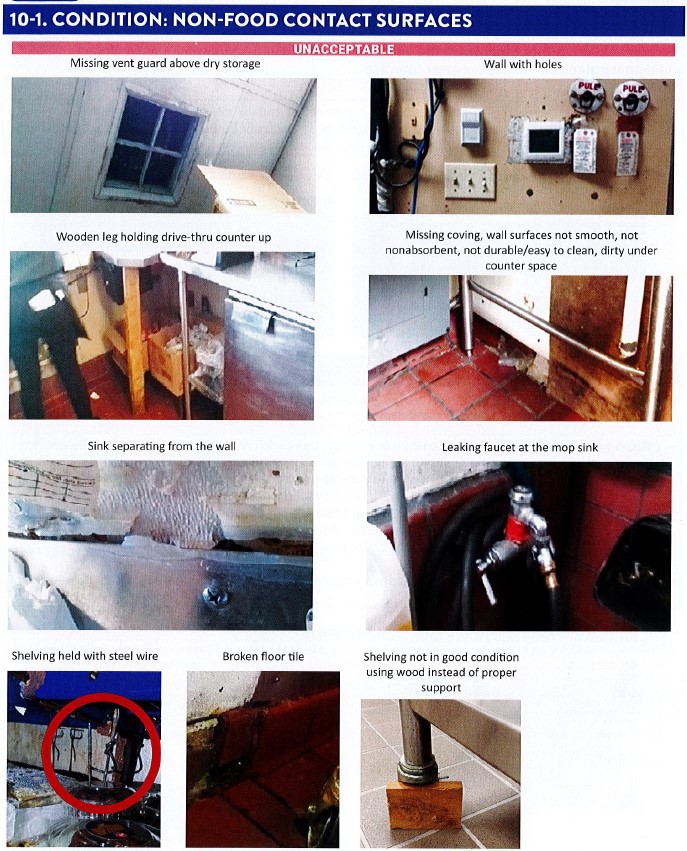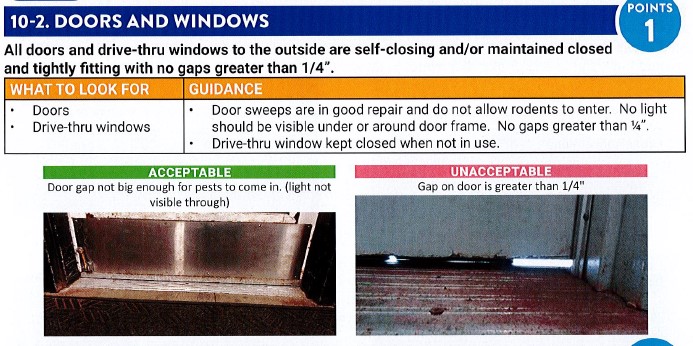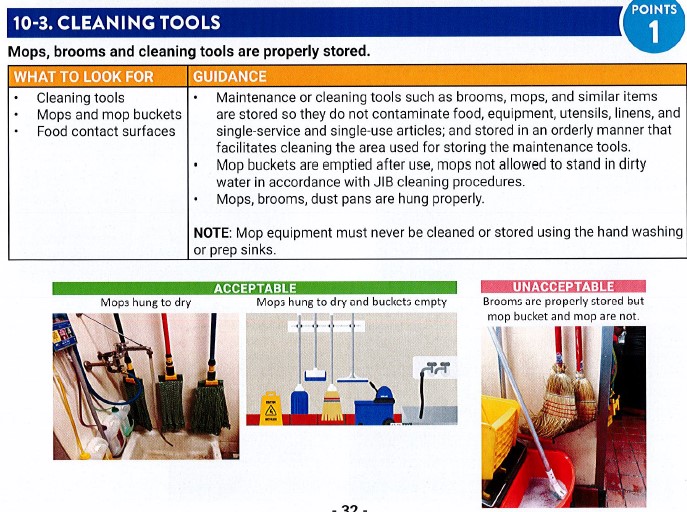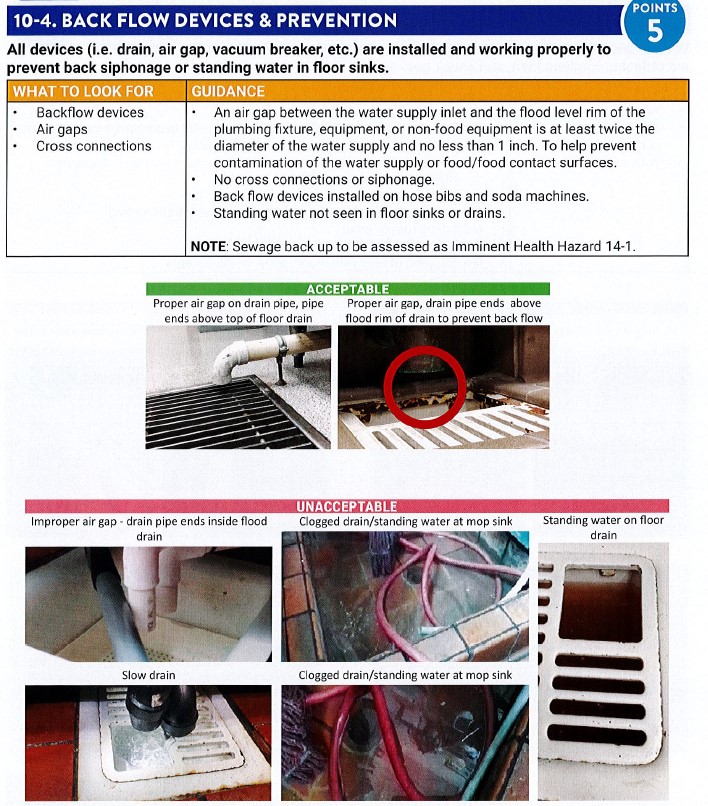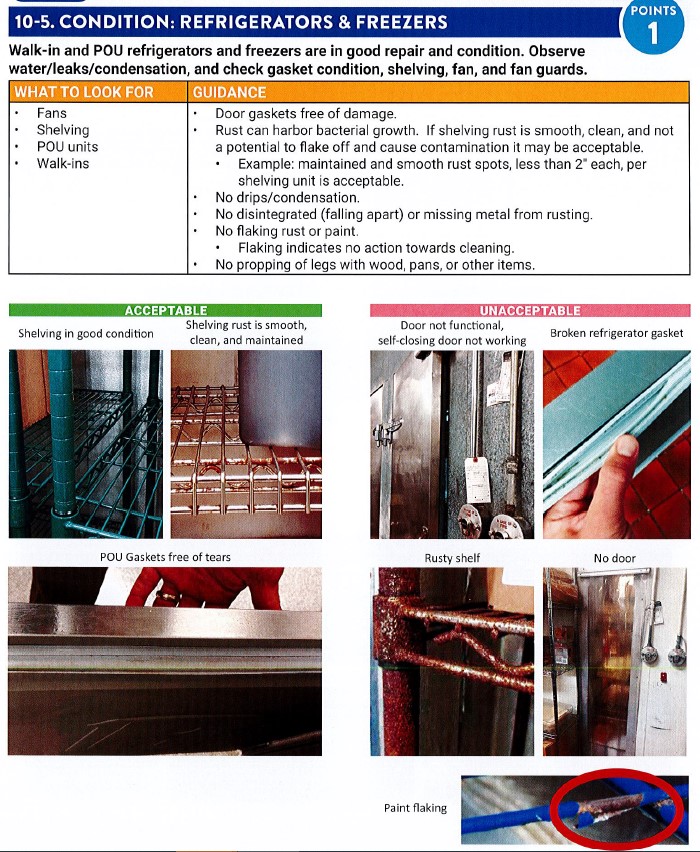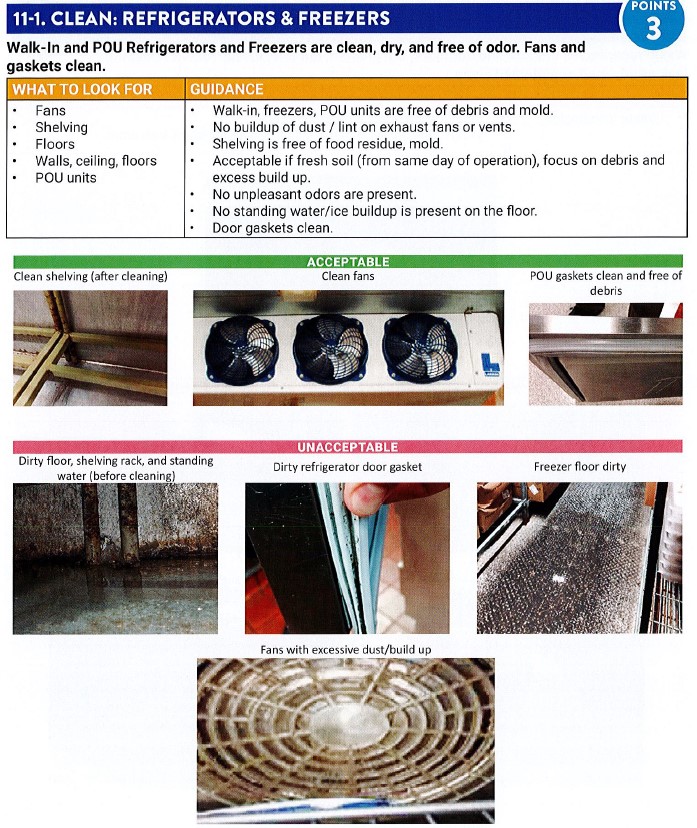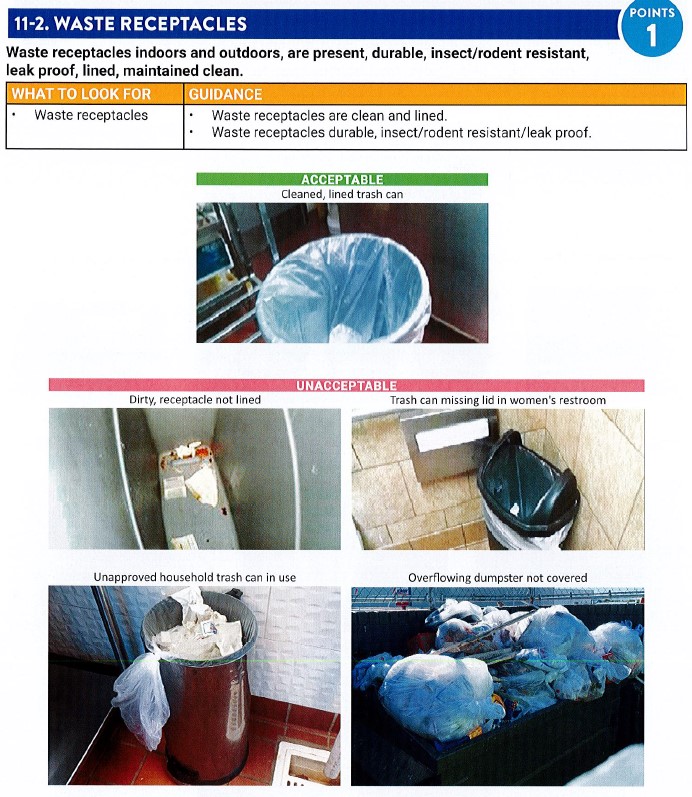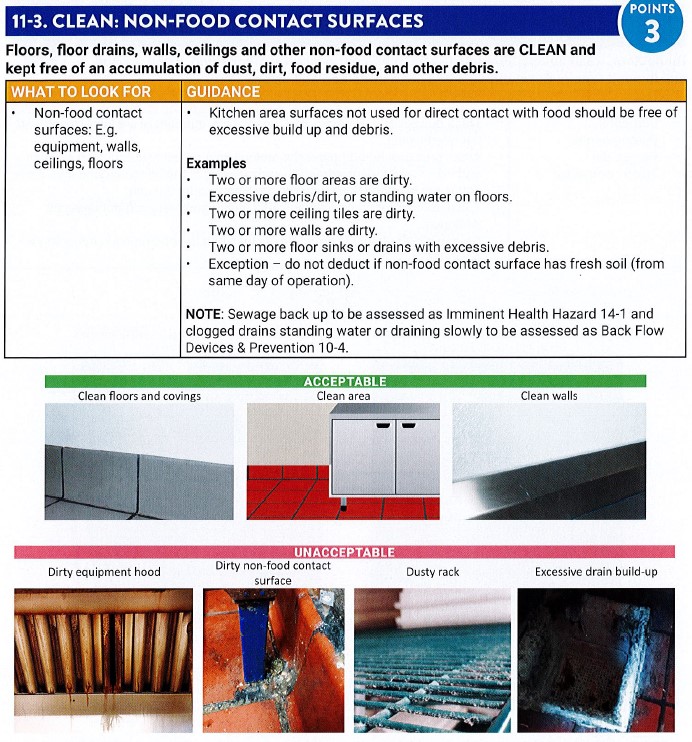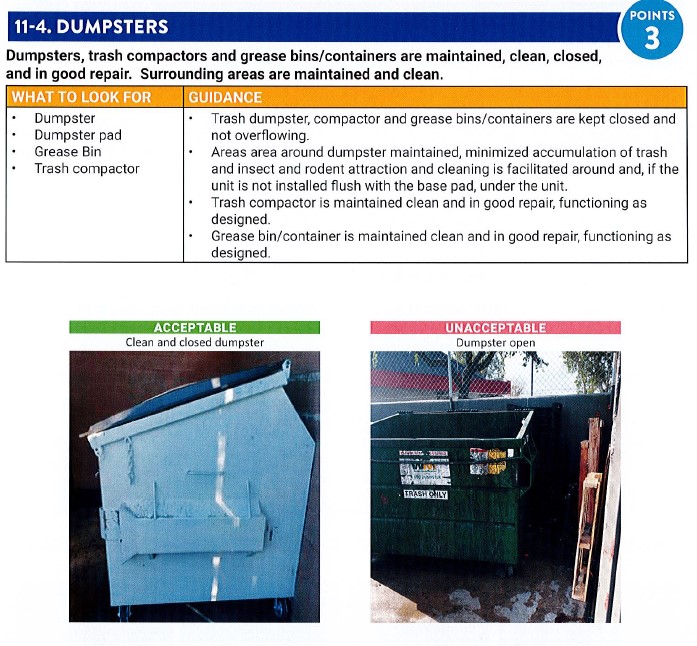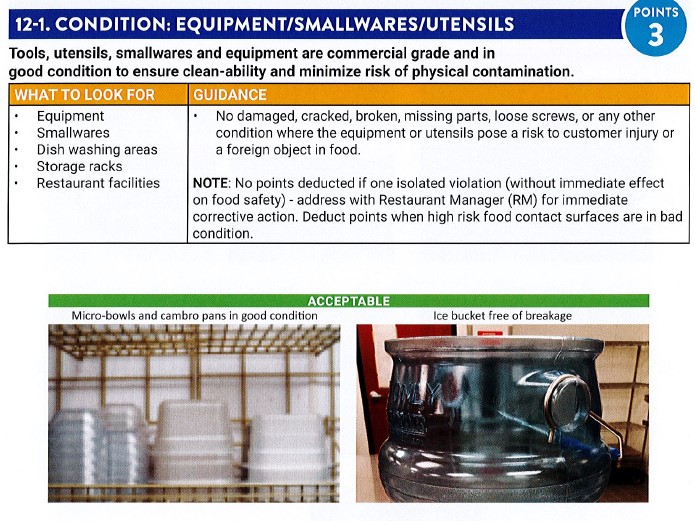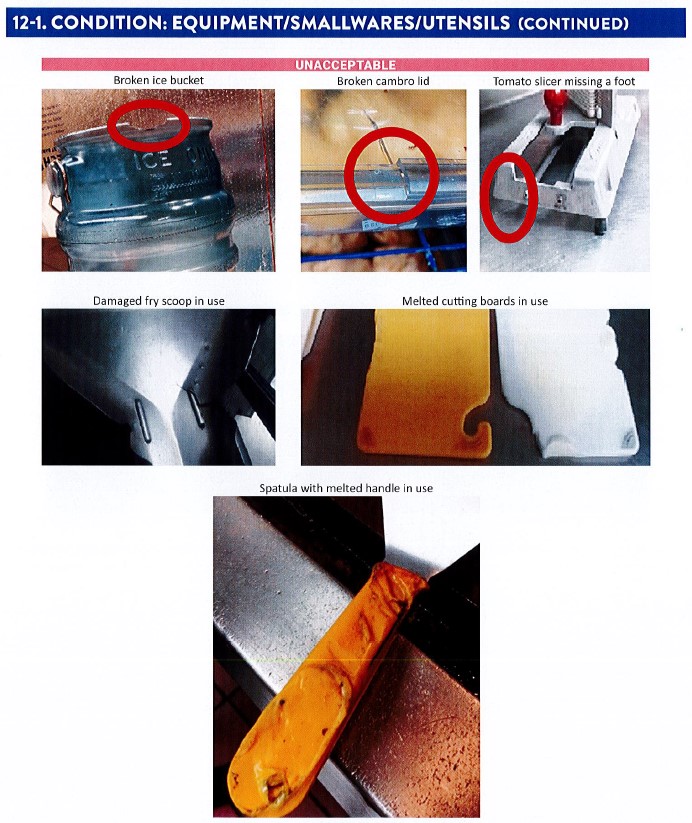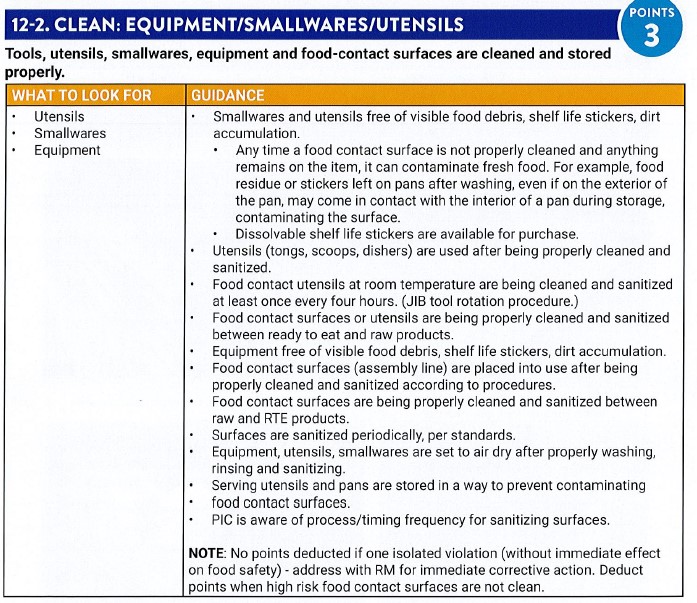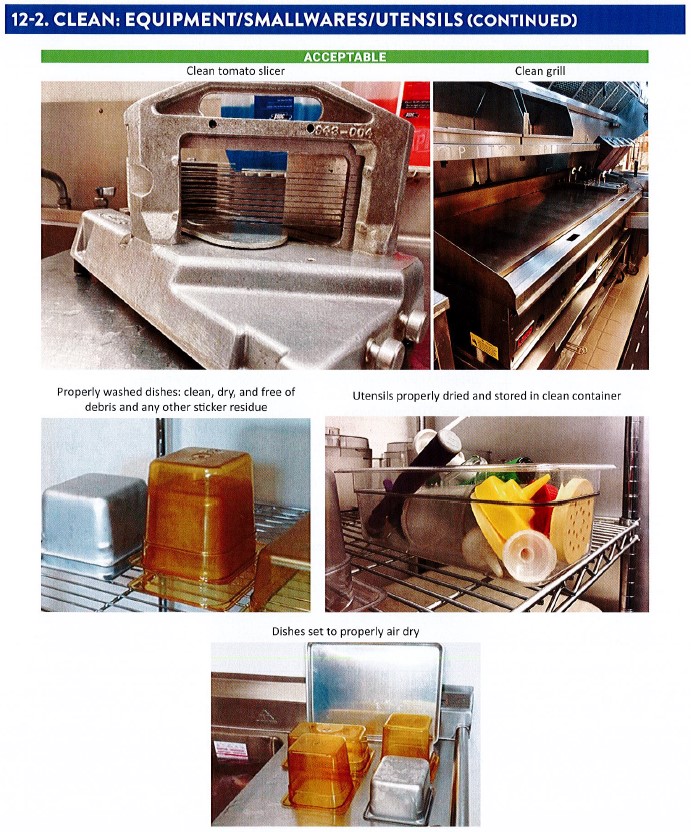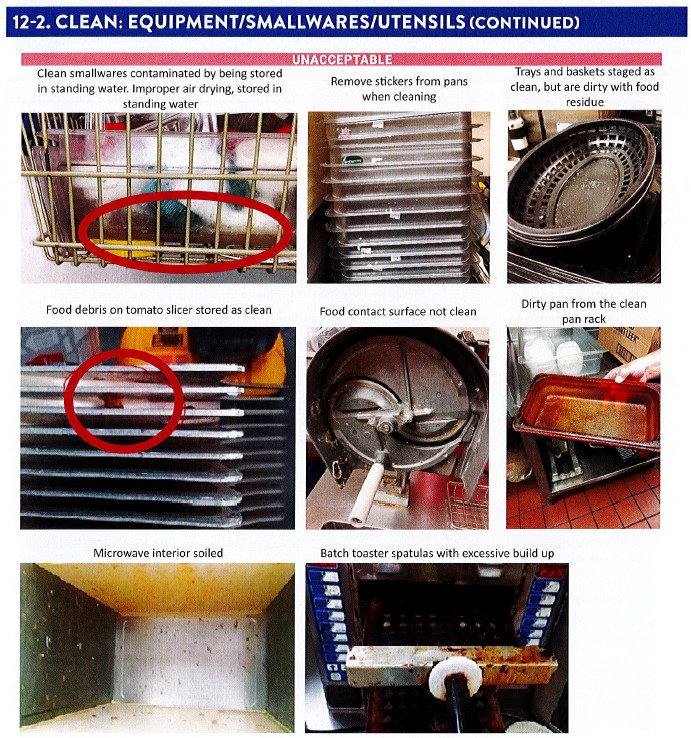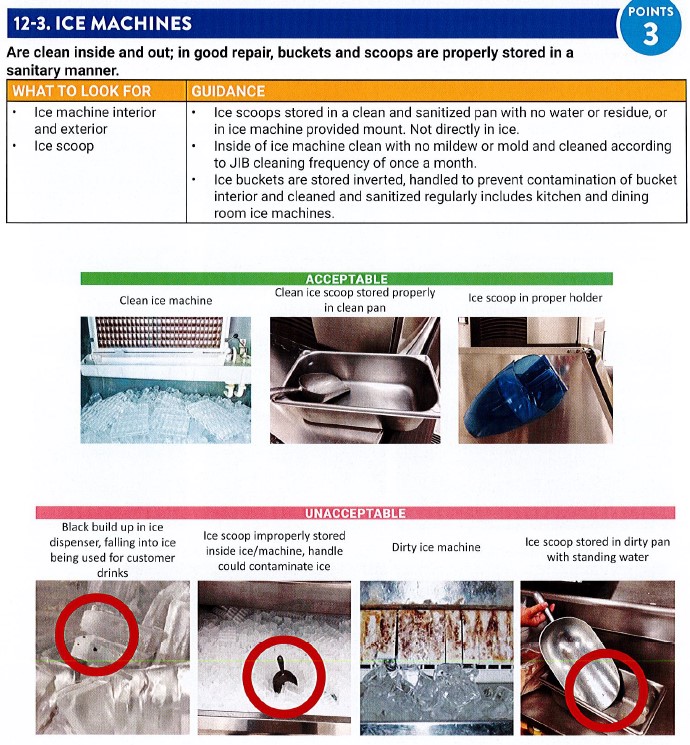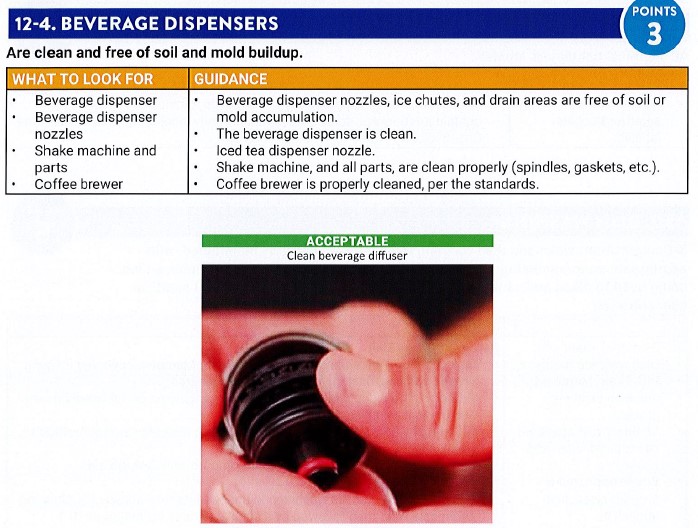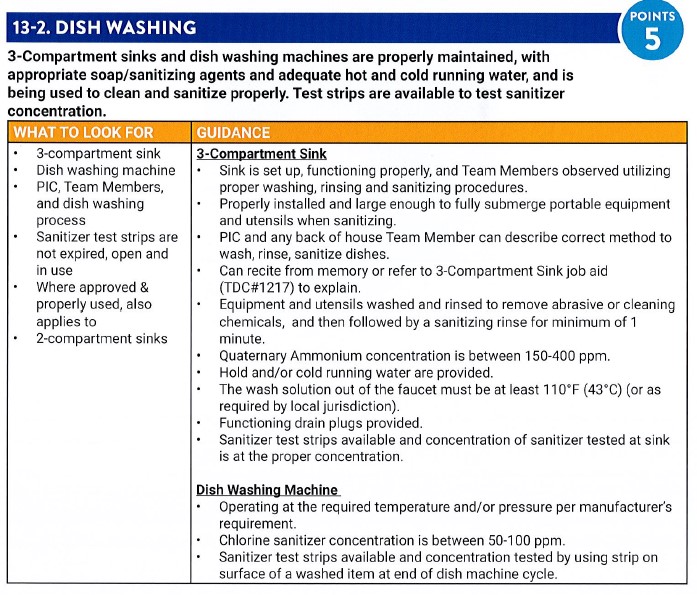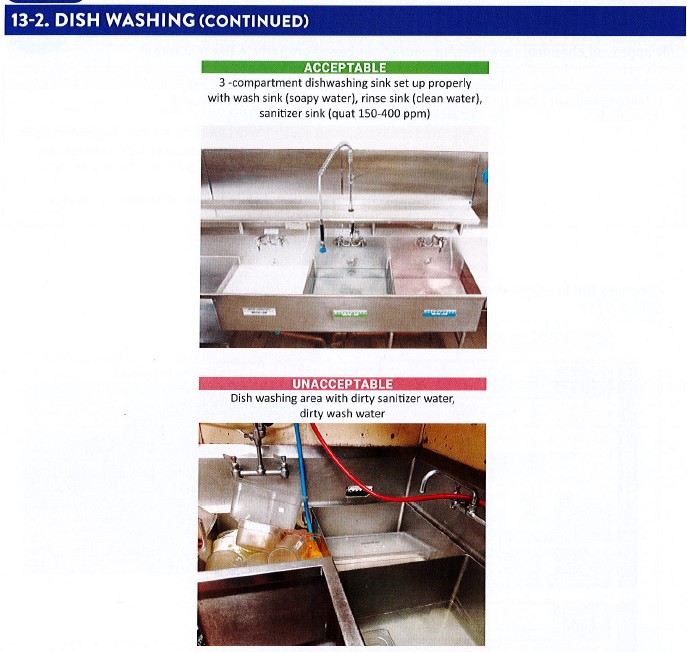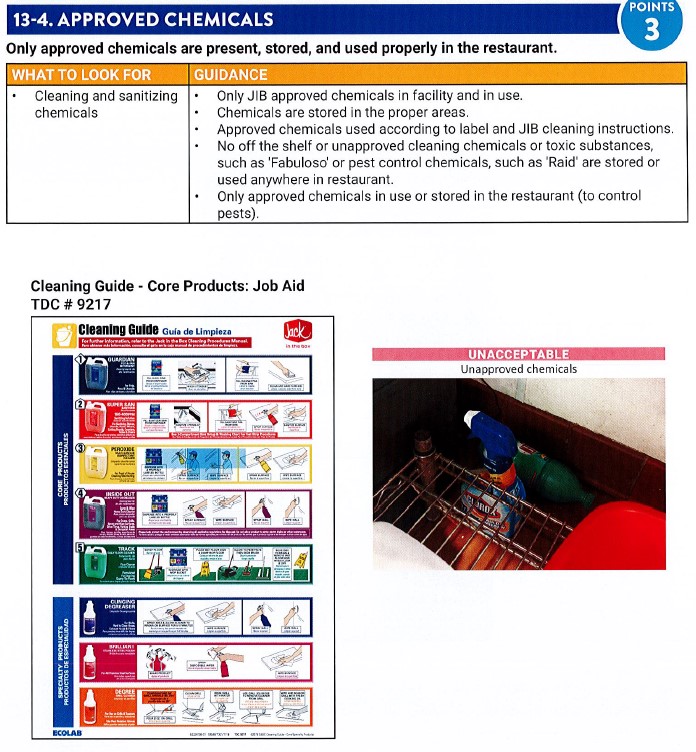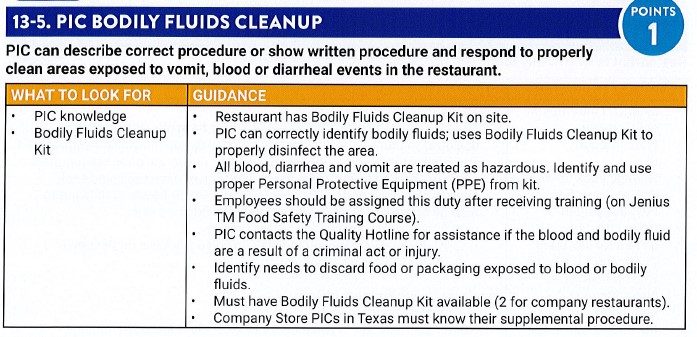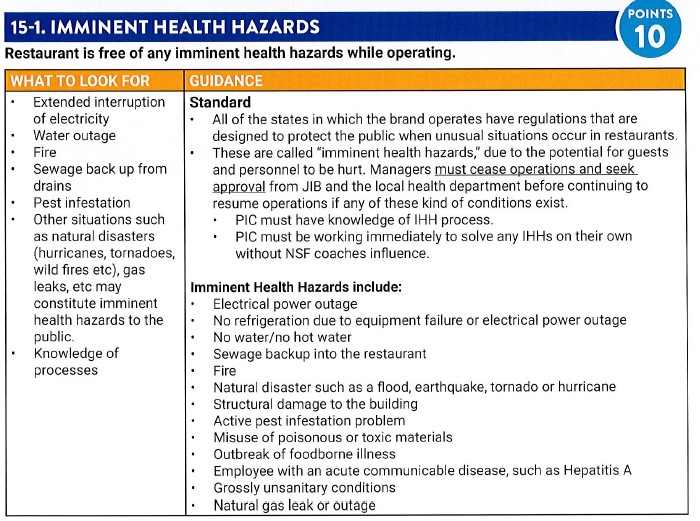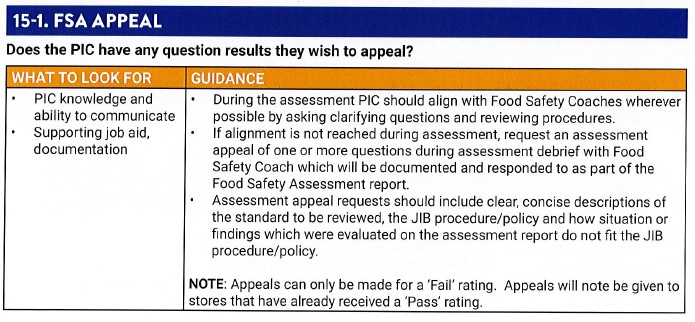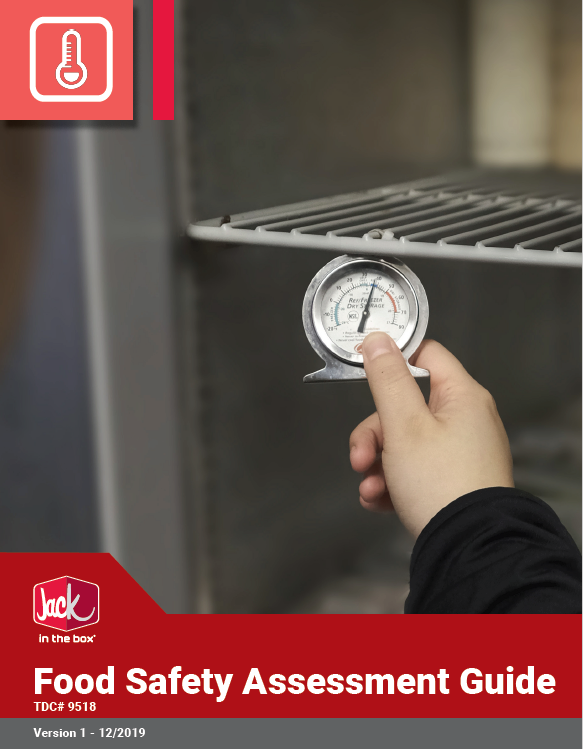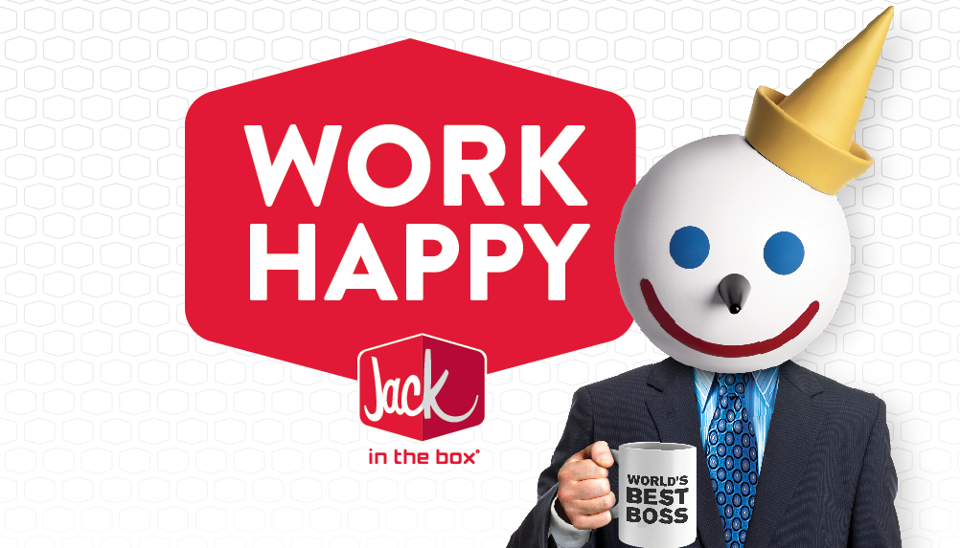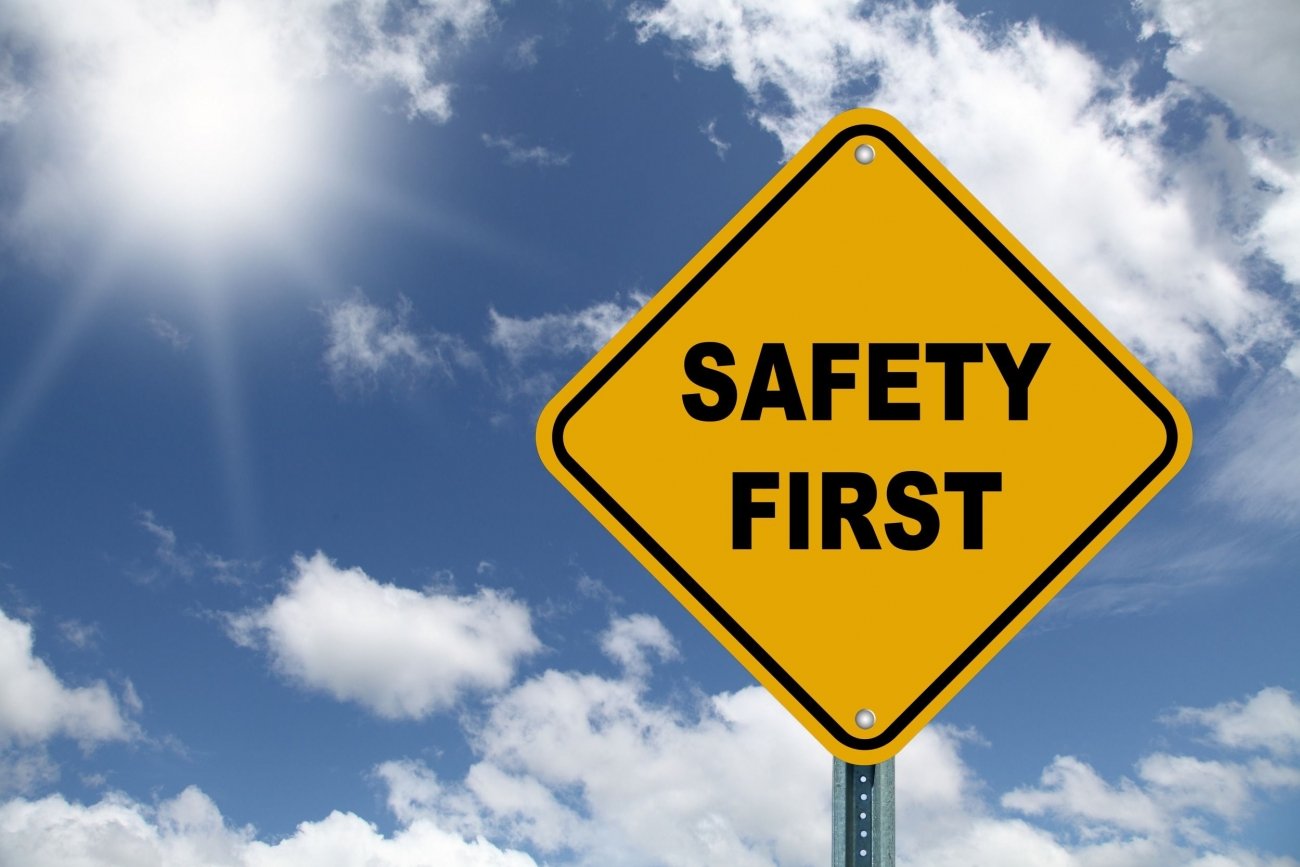Title Page
-
Conducted on
-
Prepared by
-
Location
- 8201 Dillingham
- 8203 Umi
- 8204 McCully
- 8205 Kam IV
- 8206 Waipahu
- 8207 Waimanalo
- 8208 Kapiolani
- 8209 Wahiawa
- 8210 Kapahulu
- 8211 Kaneohe
- 8212 Kahului
- 8213 Stadium
- 8217 Waipio
- 8219 Kailua
- 8222 Kihei
- 8223 Hilo
- 8227 Bishop
- 8230 Moanalua
- 8233 Waimalu
- 8237 King/Kalakaua
- 8244 Piikoi
- 8245 Wailuku
- 8246 Kapolei
- 8249 Kunia
- 8251 Kona
- 8252 Waianae
- 8253 Lihue
- 8254 Ala Moana
- 8255 Tamuning
- 8256 Niu Vlley
- 8259 Mililani
-
PIC Name
-
FINAL SCORE
-
Passing= 85% or higher (over 125 points)
-
Instructions for each question will be underneath the question. Once an answer is selected, the instructions will be hidden. To view the instructions again, deselect the answer. Bonus points will be evaluated at the end of the audit.
1. GENERAL
-
1-1 Manager Certification
-
Check that Restaurant Manager has a current ServSafe Managers certification. (For Guam, also assess that all Team Leaders have a current ServSafe Certification.) All Team Leaders have TL Food Safety certification.
-
1-2 General Policies & Knowledge Checks
-
-
1-3 Health Department Inspection & Failed FSA
-
Most recent health inspection report is at the restaurant, and all deficiencies have been addressed.
-
All noted deficiencies and corrective actions have been addressed on the most recent health inspection report and on the most recent failed FSA. PIC can demonstrate knowledge of health inspection procedure.
-
1-4 Food Safety Checklist
-
Daily food safety checklist, thermometer calibration, and corrective actions taken.
2. EMPLOYEE HEALTH & HYGIENE
-
2-1 Illness
-
Food handlers have no obvious signs of illness/not working when sick or with infected or open wounds. Illness policy visibly posted and PIC can demonstrate knowledge of policy.
-
2-2 Personal Items
-
Eating, drinking, smoking, gum-chewing, and personal items are not allowed at workstations and are kept separate from food and beverage areas.
-
-
2-3 Personal Hygiene
-
All restaurant employees follow dress code requirements.
3. Pest Control
-
3-1 Pest Prevention
-
RM effectively controlling pests.
-
3-2 Pest Activity
-
The restaurant is free of signs of pest activity
4. HANDWASHING/HAND SINKS
-
4-1 Handwashing Sinks
-
Handwashing sinks in kitchen areas are available, accessible, working, and properly set up.
-
4-2 Handwashing Procedures
-
All employees are observed washing hands properly and only in designated handwashing sinks.
-
4-3 Glove Usage
-
Employees are properly using disposable gloves
5. FOOD RECEIVING AND STORAGE
-
5-1 Receiving
-
Evidence of food receiving to standard- Temperatures, condition, receiving and storage procedures to standard
-
5-2 Expired Products/Ingredients
-
No expired products/ingredients are noted.
-
5-3 Using Approved Food & Beverages
-
PIC can describe the correct procedures to purchase foods.
6. CONTAMINATION PREVENTION
-
6-1 STORAGE: Food and Packaging
-
Adequately covered, RTE foods stores over raw foods.
-
-
6-2 CONTAMINATION: Food & Packaging
-
-
6-3 Washing Produce
-
Fruits and vegetables are properly washed before use.
-
6-4 Lighting
-
Lighting is adequate and all lights are clean and properly shielded or shatterproof.
7. TEMPERATURE CONTROL/STORAGE
-
7-1 Food Thermometers
-
Food thermometers are available, operational and accurate; employees can demonstrate the proper procedure to calibrate and use the instrument.
-
7-2 Equipment Thermometers & Temperatures
-
Equipment dial thermometers are present, functional and located in the warmest part of the refrigerator or freezer unit. Equipment is functioning properly.
-
7-3 Product Prep Time & Temperatures
-
TCS foods in walk-ins and POUs are at a temperature of 41F or below, and frozen foods maintain freezing temperature. Time of TCS foods effectively monitored during prep and thaw.
8. TEMPERATURE CONTROL/PREPARATION/STAGING
-
8-1 TPHC
-
Approved time as a public health control (TPHC) procedures are followed.
-
8-2 Hot Holding
-
Hot TCS foods are held at a temperature of 135F or above.
9. COOKING TEMPERATURES
-
9-1 Cooking
-
Required cooking time procedures for TCS foods are followed.
-
9-2 Final Flip and Check
-
JIB final flip and visual check followed.
-
9-3 Temperature Taking & Cooking Temperatures
-
Employee can independently and without coaching demonstrate the correct procedure to take the temperature of a food item and grill, and PIC has knowledge of proper internal cooking temperatures.
10. CONDITION: NON-FOOD CONTACT
-
10-1 CONDITION: Non-Food Contact Surfaces
-
Floors, walls, ceilings and other non-food contact surfaces are properly constructed and in good condition.
-
-
10-2 Doors and Windows
-
All doors and drive thru windows to the outside are self-closing and/or maintained closed and tightly fitting with no gaps greater than 1/4".
-
10-3 Cleaning Tools
-
Mops, brooms and cleaning tools are properly stored.
-
10-4 Back Flow Devices & revention
-
All devices (e.g. air gap, vacuum breaker, etc.) are installed and working properly to prevent back siphonage or standing water in floor sinks.
-
10-5 CONDITION: Refrigerators and Freezers
-
Walk-In and POU refrigerators and freezers are in good repair and condition. Observe water/leaks/condensation, and check gasket condition, shelving, fan, and fan guards.
11. CLEANLINESS: NON-FOOD CONTACT
-
11-1 CLEAN: Refrigerators and Freezers
-
Walk-In and POU refrigerators and freezers are clean, dry, and free of odor. Fans and gaskets clean.
-
11-2 Waste Receptacles
-
Waste receptacles indoors and outdoors are present, durable, insect/rodent resistant, leak proof, lined, maintained clean.
-
11-3 CLEAN: Non-Food Contact Surfaces
-
Floors, floor drains, walls, ceilings, and other non-food contact surfaces are clean and kept free of accumulation of dust, dirt, food residue, and other debris.
-
11-4 Dumpsters
-
Dumpsters, trash compactors and grease bins/containers are maintained, clean, closed, and in good repair. Surrounding areas are maintained and clean.
12. CONDITION AND CLEANLINESS: FOOD CONTACT
-
12-1 CONDITION: Equipment/Smallwares/Utensils
-
Tools, utensils, smallwares and equipment are commercial grade and in good condition to ensure clean-ability and minimize risk of physical contamination.
-
-
12-2 CLEAN: Equipment/Smallwares/Utensils Clean
-
Tools, utensils, smallwares, and food-contact surfaces are cleaned and stored properly.
-
-
-
12-3 Ice Machines
-
Ice machines are clean inside and out, in good repair; buckets and scoops are properly stored in a sanitary manner.
-
12-4 Beverage Dispensers
-
Beverage dispensers are clean and free of soil and mold buildup.
13. SANITIZER/CHEMICALS
-
13-1 Chemicals Labeled
-
All chemical containers labeled.
-
13-2 Dish Washing
-
3-Compartment sinks and dish washing machines are properly maintained, with appropriate soap/sanitizing agents and adequate hot and cold running water. Test strips are available to test sanitizer concentration.
-
-
13-3 Sanitizer Containers
-
Sanitizer containers and wiping towels are properly used and stored, sanitizer at proper concentration.
-
13-4 Approved Chemicals
-
Only approved chemicals are present, stored, and used properly in the restaurant.
-
13-5 PIC Bodily Fluids Cleanup
-
PIC can describe correct procedures or show written procedure and respond to properly clean areas exposed to vomit, blood or diarrheal events in the restaurant.
14. IMMINENT HEALTH HAZARDS
-
14-1 Imminent Health Hazards
-
Restaurant is free of any imminent health hazards while operating.
15. APPEAL
-
15-1 FSA Appeal
-
Does the PIC have any question results they wish to appeal?
